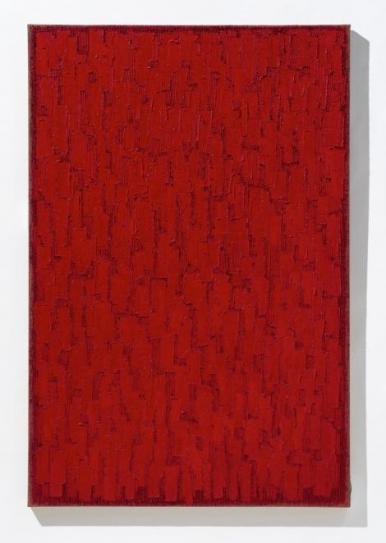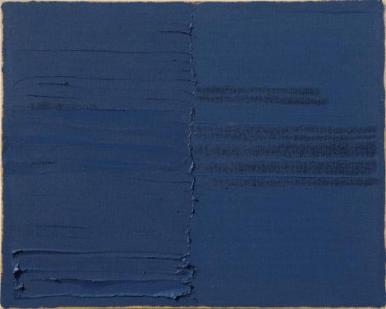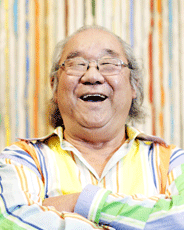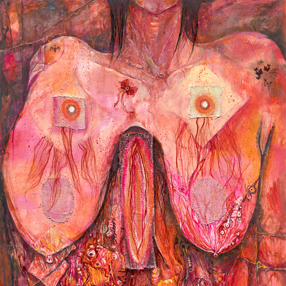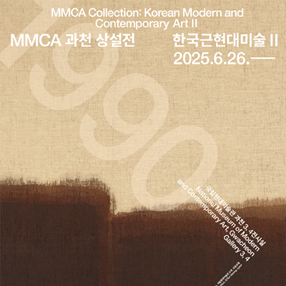본문
-
하종현
Conjunction 18-12, 2018 Oil on hemp cloth 227 x 182 cm Courtesy of the artist and Kukje Gallery Image provided by Kukje Gallery
하종현
Conjunction 15-169, 2015 Oil on hemp cloth 162 x 130 cm Courtesy of the artist and Kukje Gallery Image provided by Kukje Gallery
하종현
Conjunction 17-95, 2017 Oil on hemp cloth 180 x 120 cm Courtesy of the artist and Kukje Gallery Image provided by Kukje Gallery
하종현
Conjunction 18-52, 2018 Oil on hemp cloth 162 x 130 cm Courtesy of the artist and Kukje Gallery Image provided by Kukje Gallery
하종현
Conjunction 15-312, 2015 Oil on hemp cloth 130 x 162 cm Courtesy of the artist and Kukje Gallery Image provided by Kukje Gallery
하종현
전시전경,
Press Release
“I borrowed the element of fire to compress the depth of time.”
– Ha Chong-Hyun
Kukje Gallery is pleased to present Ha Chong-Hyun, on view from May 29 to July 28, 2019, at the gallery’s Busan space. Comprised of over ten recent works, Ha Chong-Hyun marks the artist’s first solo exhibition in Korea in nearly four years, and his first in Busan. Ha has a long relationship with the Yeongnam region in which Busan and Daegu are located, having been in the group exhibition Renegades in Resistance and Challenge at Daegu Art Museum (2018) and the Busan Biennale (2016, 2008). Best known for his experimentation with paint and commitment to asking, “what is painting?” Ha’s exhibition in Busan focuses on works from his celebrated Conjunction series, with special emphasis on his expanding exploration of color as well as his innovative use of smoke and fire to transform the surface of his paintings.
This commitment to experimentation is a continuation of the work he showed at Kukje Gallery’s Seoul branch in 2015. In that show, Ha introduced a series of Conjunction paintings that utilized a “smoking” technique invented by the artist where thick, sooty smoke is applied to wet paint, leaving exquisite and unpredictable colors. A gasoline-soaked torch is held near the wet painting, allowing the heavy char smoke to naturally saturate the painted surface. This technique was the result of Ha’s desire to replicate colors of nature that cannot be artificially made, revealing the artist’s embracement of chance in his practice. In addition, Ha began utilizing subtle colors reminiscent of traditional Korean roof tiles or giwa, as well as tones evoking brick, soil, and silvergrass. Ha Chong-Hyun will be the artist’s first exhibition in Korea to include large Conjunction paintings made with a new palette including red, blue, and vermillion (a combination of red and orange known as dahongsaek). One recent example of this interest in the symbolic role of color is Conjunction 18-41 (2018) where the artist plays with the subtle correspondence of broad black strokes on the natural hemp to convey not only the somber and rich black palette, but the organic color of a giwa roof that has weathered over time.
Ha’s interest in color is rooted in the artist’s longstanding practice of careful observation of the landscape and appropriating everyday materials—reframing them as formal language—an investigation that goes back to his earliest works. From 1962 to 1968, Ha devoted himself to making abstract oil paintings in the style of the improvisational abstract art movement known as Art Informel. From 1969, following the founding of the Korean Avant Garde Association, through the mid-1970s, Ha went through a period of expansive “material exploration" centered on objects such as plaster, newspaper, wood, rope, and wooden boxes. During this time, Ha Chong-Hyun sought out non-artistic and non-traditional media such as flour, newspaper, steel springs, and barbed wire, and began utilizing both sides of the canvas made of rough burlap sacks that carried USAID rations following the Korean War. Exploiting the unique ground material, Ha established an innovative method where he applies thick oil paint to the back of and pushes it to the front of the surface through the coarse weave, a process known as bae-ap-bub. This became the basis of his signature Conjunction series. The thick striated paint that oozes to the front is then freely transformed by the artist using tools such as knives, brushes, and wooden spatulas which Ha appropriately modifies in order to create the patterns that accentuate the pictorial plane. It is this process that results in the piece becoming a “conjunction” between material and performance. This unconventional methodology illustrates Ha’s defiant attitude towards preexisting hierarchies and modes of painting.
For his exhibition in Busan, Ha’s use of red, blue, and vermillion shows the artist’s commitment to exploring colors seen in mundane surroundings in Korea. In particular, the vermillion color is new, having become part of Ha’s practice only last year. The vivid, red-orange color seen in Conjunction 18-12 (2018) was inspired by the colorful patterns known as dancheong that are used to decorate wooden structures and traditional Korean musical instruments. This will be the first time Ha is showing a painting using this color in Korea.
In another example of Ha’s ongoing commitment to experimentation, Conjunction 18-52 (2018) shows the artist using a combination of “smoking” a white oil ground and then using a thin wire, with which he gently scrapes the blackened surface exposing the white paint underneath. He then uses the wire to create a kind of calligraphic scratching across the composition, as a method that is reminiscent of Ha’s experimental period in the early 1970s during which he used barbed wire and nails.
Though he is in his mid-eighties, Ha Chong-Hyun continues to create powerful paintings with surfaces infused with materiality and energy. His vitality comes from experimentation and attests to the fact that Ha is still exploring new compositions to expand the boundaries of painting. Ha’s practice will be the subject of a number of shows, including his solo exhibition scheduled for September at Cardi Gallery in Milan. Furthermore, opening on June 21, Ha will participate in Landlord Colors: On Art, Economy, and Materiality, a group exhibition at the Cranbrook Art Museum in Michigan, displaying his 1972 barbed wire work and Conjunction paintings from the first half of 1979 alongside artists including Lucio Fontana, Jannis Kounellis, and South Korea's Park Seo-Bo, Kwon Young-Woo, and Yun Hyong-Keun. In July, he will participate with the Korean artist Kim Tschang-Yeul in Abstraction, a group exhibition at Song Art Museum in Beijing, showcasing a series of large-scale red, blue, and white Conjunction paintings. In February 2020, Ha will hold a solo exhibition at Almine Rech Gallery in London.
About the Artist
Born in 1935 in Sancheong, Ha Chong-Hyun graduated from Hongik University in 1959 and served as the Dean of the Fine Arts College at Hongik University from 1990 to 1994. He was the Director of the Seoul Museum of Art from 2001 to 2006. Ha has been the focus of major retrospectives at the National Museum of Modern and Contemporary Art, Korea, Gwacheon (2012); Gyeongnam Museum of Art, Changwon (2004); Fondazione Mudima, Milan (2003); and has recently held solo exhibitions in New York, London, Tokyo, and Paris. Ha has been acknowledged as a founding representative of Dansaekhwa, participating in group exhibitions including Korean Abstract Art: Kim Whanki and Dansaekhwa (2018) at the Powerlong Museum in Shanghai; When Process becomes Form: Dansaekhwa and Korean Abstraction (2016) at Villa Empain – Boghossian Foundation, Brussels; Dansaekhwa (2015), an official Collateral Event in the 56th Venice Biennale; and Dansaekhwa: Korean Monochrome Painting (2012) at the National Museum of Modern and Contemporary Art, Korea, Seoul. His works are housed in the collections of prominent institutions around the world, including the Museum of Modern Art and Solomon R. Guggenheim Museum, New York; the Art Institute of Chicago; the National Museum of Modern and Contemporary Art, Korea; Leeum, Samsung Museum of Art, Seoul; M+, Hong Kong; Tokyo Metropolitan Art Museum; Museum Voorlinden, Wassenaar; and OCT Boxes Art Museum, Guangzhou, among others.
국제갤러리는 오는 5월 29일부터 7월 28일까지 한국 화단을 대표하는 작가 하종현의 개인전 《Ha Chong-Hyun》을 부산점에서 개최한다. 최근 LA, 파리, 런던, 뉴욕, 도쿄 개인전 등 국제활동에 주력해온 하종현은 국내에서 4년 만에, 부산에서의 첫 개인전을 통해 수십여 년 동안 천착해온 대표 연작 ‘접합(Conjunction)’의 근작 및 신작 10여 점을 선보일 예정이다. 지난 2015년 국제갤러리 서울점 개인전에서 ‘그을림(smoke)’ 기법을 비롯해 기왓장, 벽돌, 흙, 억새풀 등 자연의 색을 연상케 하는 ‘접합’ 신작을 처음 소개했다면, 이번 전시에서는 국내 최초로 작가가 근래 새롭게 도입한 적색과 청색, 다홍색의 대형 크기 ‘접합’ 연작을 공개한다. 지난 몇 년간 영남권에서 하종현은 부산비엔날레(2016), 대구미술관 그룹전 《저항과 도전의 이단아들》(2018)을 통해 1970년대 초 철조망 작품과 AG 관련한 신문 설치 작품을 전시한 바 있다.
하종현은 ‘회화란 무엇인가’라는 질문을 바탕으로 50여 년에 걸쳐 유화를 다뤄왔다. 1962년부터 1968년까지 작가는 즉흥적인 추상예술 경향인 앵포르멜 스타일의 추상 유화 작업에 몰두했다. 이후 전위적 미술가 그룹인 한국아방가르드협회(AG)를 결성한 1969년부터 1970년대 중반까지 석고, 신문지, 각목, 로프, 나무상자 등 오브제를 중심으로 한 ‘물성 탐구의 기간’을 거쳤다. 이 시기에 작가는 한국전쟁 이후 미군 군량미를 담아 보내던 마대자루를 비롯해 밀가루, 신문, 용수철, 철조망 등 비(非)미술적이고 비(非)전통적 매체로 캔버스의 양면을 모두 활용하는 실험적인 작업방식을 시도했다. 그리고 1974년부터 지금까지 마대자루를 활용한 경험에서 출발, 고유한 기법으로 자리매김한 ‘접합’ 연작을 완성해가는 중이다.
하종현은 올이 굵은 마포 뒷면에 두터운 물감을 바르고 천의 앞면으로 밀어 넣는 배압법(背押法)을 통해 독창적인 작업 방식을 구축했다. 앞면으로 배어 나온 걸쭉한 물감 알갱이들은 나이프나 붓, 나무 주걱과 같은 도구를 사용한 작가의 개입으로 다시 자유롭게 변주되고, 마침내 물질과 행위의 흔적이 결합된 결과물로 완성된다. 특히 캔버스 뒷면에서 앞면으로 물감을 밀어내는 방식의 파격적 방법론에는 작가가 추구해 온 기성 형식에 대한 저항적 태도가 담겨 있다. 그는 단색화 태동기부터 화면의 앞뒤를 구분하는 관행에 대한 비판적 관점을 제시해온 바 있다.
이번 《Ha Chong-Hyun》전에서는 작가가 새롭게 탐구한 색채의 대형 크기 ‘접합’ 연작을 중점적으로 선보인다. 하종현은 일상 속 익숙한 대상에서 색을 발견하고 이를 조형적인 언어로 치환하는 과정을 작업의 중요한 지점으로 삼고 있다. 마포 고유의 색이 완전히 없어질 정도로 검게 칠한 작품 < Conjunction 18-41 >(2018)은 단순히 어둡거나 인공적인 검은 톤의 색채가 아닌, 오랫동안 비를 맞은 기와가 세월에 퇴색된 듯한 자연적인 성향의 색채라 할 수 있다.
하종현은 최근 적색과 청색, 그리고 지난해 말부터 다홍색을 ‘접합’에 도입했다. 대표적으로 작품 < Conjunction 18-12 >(2018)에서 보이는 선명한 다홍색은 단청과 한국전통악기의 화려한 문양에서 영감을 받아 제작한 것이다. 다홍색의 ‘접합’ 연작은 올해 초 ‘프리즈 LA’ 아트페어 국제갤러리 부스에서 처음 선보였으며, 3월 도쿄 블럼앤포 갤러리 개인전에서 작은 크기의 작품으로 소개된 데 이어 국내에서는 이번 전시를 통해 처음 공개된다.
이번에 소개되는 < Conjunction 18-52 >(2018) 역시 마포에 검은색 물감을 칠한 다음, 뒷면에서 흰색 물감을 밀어내어 앞면의 표면에 그을음을 입힌 작품이다. 작가는 검게 그을린 표면을 다시 살짝 긁어내 음각의 형태로 흰색 물감을 노출시키고, 그 위에 얇은 철사를 사용해 서체와 같은 일종의 표식을 만들어냈다. 이는 1970년대 초 작가가 주력한 철조망과 용수철, 그리고 못을 사용했던 실험적인 시도를 연상시킨다.
앞서 하종현은 2015년 국제갤러리 개인전에서 새롭게 물감에 그을음을 씌운 기법을 선보인 바 있다. 마포 앞면의 물감이 마르기 전에 횃불처럼 나무 막대기에 천을 두르고 휘발유를 부은 다음 불을 붙이면 검은 연기가 피어오르는데, 이 연기를 캔버스 앞면에 밀려나온 물감에 씌우는 방식이다. 작가는 “그을린 물감을 앞쪽에서 펴 바르거나 밀어내면 예상하지 못한 묘한 색채가 나타난다”며 “시간의 깊이를 압축해 담아내는 과정에서 불의 힘을 빌렸다”고 밝힌 바 있다. 이는 인공적으로는 형상화할 수 없는 자연의 색을 얻기 위한 방법론의 고민에서 나온 결과물로, 자연이 주는 우연성을 수용하는 작가의 태도를 드러낸다.
현재도 하종현은 1935년생이라는 사실이 무색할 정도로 매일 물성과 에너지가 넘치는 화면을 구성하는 작업을 이어가고 있다. 이는 작가가 여전히 새로운 구성을 탐구하면서 회화의 방법론을 확장시키고 무한한 가능성을 탐색 중임을 증명한다. 특히 올해 하종현은 어느 때보다 바쁜 행보를 보이고 있다. 오는 9월 밀라노 카디 갤러리에서 개인전을 앞두고 있으며, 2020년 2월에는 런던 알민레쉬 갤러리에서의 개인전이 예정되어 있다. 또한 오는 6월 21일부터는 미국 미시간주 크랜브룩 현대미술관에서의 그룹전 《주인의 색채: 예술, 경제 및 물성에 대해》에서 루치오 폰타나, 야니스 쿠넬리스, 한국의 박서보, 권영우, 윤형근과 함께 참가해 1972년 철조망 작품과 1979년 초기 접합 작품을 전시한다. 곧이어 7월에는 중국 베이징 소재의 송 현대미술관 그룹전 《추상》에서 한국작가 김창열과 함께 참가해 적색과 청색, 흰색의 대형 접합 연작을 선보일 예정이다.
작가소개
1935년 경남 산청에서 출생한 하종현은 1959년 홍익대학교 회화과 졸업 후 1990년부터 1994년까지 홍익대학교 예술대학의 학장을 지냈고, 2001년부터 2006년까지 서울시립미술관 관장으로 재직하였다. 밀라노 무디마 현대미술재단(2003), 경남도립미술관(2004년), 국립현대미술관 과천관(2012)에서 열린 대규모 회고전 이후 뉴욕과 런던, 파리 등 전세계 갤러리에서 주요 개인전을 선보였으며, 한국 단색화를 대표하는 작가로서 국립현대미술관 《한국의 단색화》(2012), 제56회 베니스 비엔날레 병행전시 《단색화》(2015), 벨기에 보고시안 재단 《과정이 형태가 될 때: 단색화와 한국 추상미술》(2016), 상하이 파워롱미술관 《한국의 추상미술: 김환기와 단색화》(2018) 등 주요 단색화 그룹전에 참여했다. 하종현의 작품은 최근에 소장된 중국 박시즈 미술관, 네덜란드 보르린던 현대미술관을 비롯해 뉴욕 현대미술관(MoMA), 솔로몬 R. 구겐하임미술관, 시카고 미술관, 홍콩 M+ 미술관, 도쿄도미술관, 국립현대미술관, 삼성미술관 리움과 같은 전세계 유수의 미술관에 소장되어 있다.전시제목Ha Chong-Hyun
전시기간2019.05.29(수) - 2019.07.28(일)
참여작가 하종현
관람시간10:00am - 06:00pm
휴관일매주 월요일
장르회화
관람료무료
장소국제갤러리 Kukje Gallery (부산 수영구 구락로123번길 20 (망미동, F1963) 국제갤러리 부산)
연락처051-758-2239
Artists in This Show
1935년 경남 산청출생
국제갤러리(Kukje Gallery) Shows on Mu:um
Current Shows






